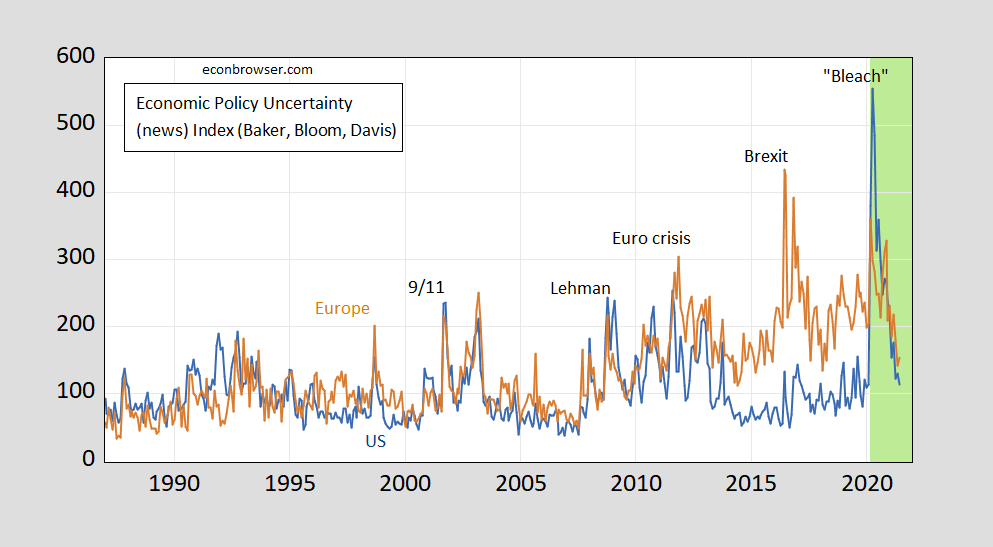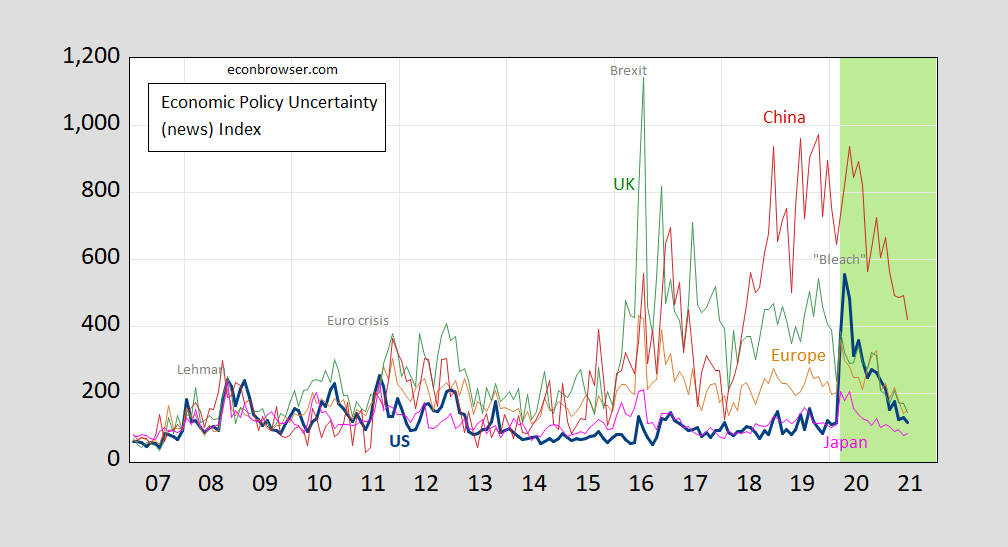I was doing a review of measured economic policy uncertainty, and found an interesting divergence between the US and Europe:
Figure 1: Economic Policy Uncertainty index (news only) for US (blue), and for Europe (brown). Light green shading denotes pandemic in US. Source: policyuncertainty.com.
Most of the peaks are interpretable as being driven by clearly defined events. The 2020M04 spike in the US is notable as (1) it comes not during the beginning of lockdowns (in March), but in April, and (2) the corresponding peak in Europe is much lower relative to average (the level of the indices are not comparable across series).
This is not a finding specific to Europe. Consider a broader look:
Figure 2: Economic Policy Uncertainty index (news only) for US (blue), Europe (brown), UK (green), China, Baker-Bloom-Davis-Wang version (red) and Japan, RIETI version (pink). Light green shading denotes pandemic in US. Source: policyuncertainty.com.
One can’t see a dynamic similar to that for the US series in any other. The US index jumps up from a relatively low level, and decays slowly. The April spike is a 38% jump (log terms); the next highest jump is in China, at 10.8% (the others go down). This leads me to believe that perceived policy uncertainty was driven particularly high during the Covid-19 pandemic by Mr. Trump’s erratic statements and actions.


This is one way we can say China’s policy reaction was superior to America’s. Neither Xi Jinping or a single member of China’s National People’s Congress ever recommended people should drink bleach. Only Manfred of Louisiana’s hero donald trump said that. This also might explain why sammy had to close his restaurant years ago. They asked for a tall glass of iced Lemonade and sammy thought they meant Mr. Clean with Lemon.
https://images.app.goo.gl/kNfDFvW1nKs9JgYR9
Susan Wright got the endorsement of Donald Trump as well as the Club for Rich People (Growth) but still lost to another Trumpian type Republican in Texas:
https://www.cnn.com/2021/07/27/politics/texas-6th-district-runoff-results/index.html
The evening cast at Faux News apparently mocked the four officers who testified claiming that this was nothing more than a political performance:
https://www.msn.com/en-us/news/us/tucker-carlson-and-laura-ingraham-mocked-the-harrowing-police-testimony-about-the-capitol-riot-with-snickers-and-a-best-political-performance-trophy/ar-AAMEyqz?ocid=uxbndlbing
Look – I am all in for free speech including the right of the stupid to say dumb things. But it is high time that the FCC shuts down the disgusting garbage aired by Faux News in the evening.
Faux Noise may just be helping to narrow the Republican base a bit. The police have historically leaned Republican no matter what city they serve in. Now the Republicans are on record attacking individual cops who were physically attacked by a Republican mob. Faux Noise is amplifying the Republican attacks. That will have at least some marginal effect on the support individual cops have for Republicans. Not very long far sighted on the part of Faux or the Republicans.
http://www.xinhuanet.com/english/2021-07/28/c_1310092046.htm
July 28, 2021
Over 1.58 bln doses of COVID-19 vaccines administered in China
BEIJING — More than 1.58 billion doses of COVID-19 vaccines had been administered in China by Tuesday, the National Health Commission said Wednesday.
[ Chinese coronavirus vaccine yearly production capacity is now 5 billion doses. Along with over 1.58 billion doses of Chinese vaccines administered domestically, another 600 million doses have been distributed internationally. A number of countries are now producing Chinese vaccines from delivered raw materials. ]
https://www.nytimes.com/2021/07/28/us/covid-schools-at-home-learning-study.html
July 28, 2021
The Pandemic Hurt These Students the Most
New research shows that all groups are behind in math and reading after disruptions during the pandemic. But it’s the most vulnerable students who experienced the steepest setbacks.
By Sarah Mervosh
How much did the pandemic affect students?
The latest research is out, and the answer is clear: dramatically.
In math and reading, students are behind where they would be after a normal year, with the most vulnerable students showing the steepest drops, according to two new reports from the consulting firm McKinsey & Company and the NWEA, a nonprofit organization that provides academic assessments.
The students did not just stall early on; the setbacks accumulated over time — and continued even after many students had returned to the classroom this spring.
The reports echo the outcomes from Texas and Indiana, some of the first states to release test results from the past school year. Both states showed significant declines in reading and math.
The findings paint an alarming picture of an education system plagued by racial and socioeconomic inequities that have only gotten worse during the coronavirus pandemic. An educational gap became a gulf.
“It’s a bitter pill to swallow,” said Karyn Lewis, a senior researcher at the NWEA and the lead author of the organization’s report, which was released on Wednesday. “It just keeps you up at night.”
For example, in math, Latino third graders performed 17 percentile points lower in spring 2021 compared with the typical achievement of Latino third graders in the spring of 2019. The decline was 15 percentile points for Black students, compared with similar students in the past, and 14 for Native students, according to the NWEA report….